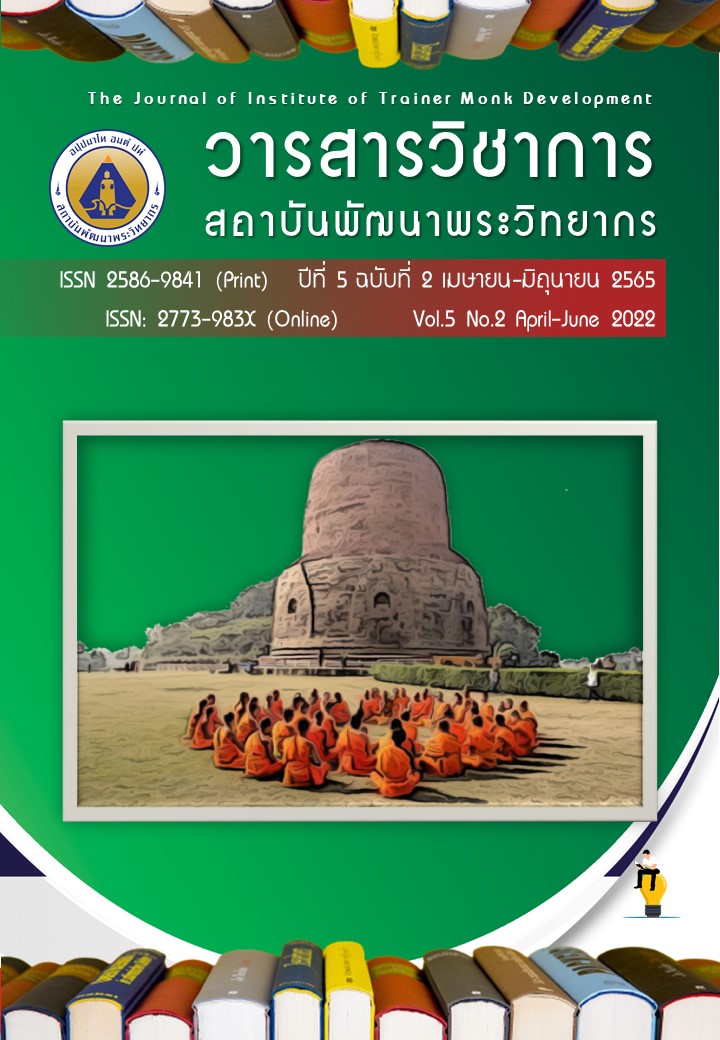A Comparative Study of the Reflectional Being of the Mara in Theravada Buddhism and Satan in Roman Catholic Christianity
Main Article Content
Abstract
This Research article aimed to study to compare the reflected image of Mara in Theravada Buddhism with Satan in Christianity of Roman Catholic. This is qualitative research collecting data from documentaries and related literatures. The results revealed that
1) The reflected Being of Mara in Theravada Buddhism indicates that Mara is the Tempter of the virtues of all human beings. It always presents as the obstacle or the destroyer of opportunities of doing good, merit and achievement or dhamma attainment. It urges human beings to do evils, to beguile in carelessness, to neglect the wholesome and to be attached with dhamma and terrifying human beings afar from good deeds or out of practices.
2) The reflected Being of Satan in Christianity of Roman Catholic demonstrates that Satan is angel besteading God. Afterwards, unwholesome sin occurred in his mind and making himself betrayed opponent. It always displays of represent or symbol of all evils, natural or moral. It stimulates human beings to do evils, or in dread and bring about diseases, dangers and dark blind to human being with complicating in the doctrine teaching
3) Both religions, on the same perspective, indicate reflected image as the obstacle or the destroyer of the good, urging, stimulating or defrauding human being to do evils and bringing about unwholesome dark blinded defilement to human mind. Drawing of disease to human being is on the different perspective. The point of view of Theravada Buddhism indicates that it occurs naturally but persuading of Satan, in Christianity of Roman Catholic.
Article Details

This work is licensed under a Creative Commons Attribution-NonCommercial-NoDerivatives 4.0 International License.
บทความที่ได้รับการตีพิมพ์เป็นลิขสิทธิ์ของวารสารวิชาการสถาบันพัฒนาพระวิทยากร
ข้อความที่ปรากฎอยู่ในบทความที่ได้รับการตีพิมพ์ในวารสาร ถือเป็นความรับผิดชอบของผู้เขียนบทความ และข้อคิดเห็นนั้นไม่ถือว่าเป็นทัศนะและความรับผิดชอบของกองบรรณาธิการวารสารวิชาการสถาบันพัฒนาพระวิทยากร
References
คณะกรรมการคาทอลิกเพื่อคริสตศาสนธรรม แผนกพระคัมภีร์. (2014). พระคัมภีร์คาทอลิก ฉบับสมบูรณ์. กรุงเทพมหานคร: คณะกรรมการคาทอลิกเพื่อคริสตศาสนธรรม.
คณะกรรมการคาทอลิกเพื่อพระคัมภีร์. (2002). พระคัมภีร์ภาคพันธสัญญาใหม่. นครปฐม: สํานักมิสชังคาทอลิก.
นงลักษณ์ เทพสวัสดิ์. (2552). วิเคราะห์ปัญหาสำคัญในสังคมไทย. พิมพ์ครั้งที่ 3. กรุงเทพมหานคร: โรงพิมพ์มหาวิทยาลัยธรรมศาสตร์.
บาทหลวงวุฒิเลิศ แห่ล้อม. (2555). หลักธรรมคำสอนคาทอลิก. พิมพ์ครั้งที่ 3. เชียงใหม่: สำนักมิสซังคาทอลิกเชียงใหม่.
ปานทิพย์ ศุภนคร. (2517). ศึกษาวิเคราะห์เรื่องปัญหาความชั่วร้ายในปรัชญาฝ่ายคริสต์. วิทยานิพนธ์อักษรศาสตรมหาบัณฑิต. บัณฑิตวิทยาลัย: จุฬาลงกรณ์มหาวิทยาลัย.
พระมหาวิชัย กิตฺติวณฺโณ (เสาพะเนา). (2555). การศึกษาเรื่องมารในคัมภีร์พระพุทธศาสนาพุทธ
เถรวาท. วิทยานิพนธ์พุทธศาสตรมหาบัณฑิต. บัณฑิตวิทยาลัย: มหาวิทยาลัยมหาจุฬาลงกรณราชวิทยาลัย.
พระพรหมคุณาภรณ์ (ป.อ.ปยุตฺโต). (2556). พจนานุกรมพุทธศาสน์ ฉบับประมวลศัพท์. พิมพ์ครั้งที่.26 กรุงเทพมหานคร: มหาจุฬาลงกรณราชวิทยาลัย.
พัชรี วชิระนิเวศ. (2544). การศึกษาเปรียบเทียบคำสอนและทัศนะเรื่องมารตามที่ปรากฏในคัมภีร์พระไตรปิฎกของศาสนาพุทธ และคัมภีร์ไบเบิลในศาสนาคริสต์. วิทยานิพนธ์อักษร-
ศาสตรมหาบัณฑิต. บัณฑิตวิทยาลัย: มหาวิทยาลัยมหิดล.
พิษณุ อรรฆภิญญ์. (1991). ศัพทานุกรมพระคัมภีร์ฉบับรวมเล่ม. กรุงเทพมหานคร: สุริยบรรณ.
ราชบัณฑิตยสถาน. (2552). พจนานุกรมศัพท์ศาสนาสากล ฉบับราชบัณฑิตยสถาน. กรุงเทพมหานคร: ราชบัณฑิตยสถาน.
วรยุทธ ศรีวรกุล. (2541). ปัญหาเรื่องความชั่วร้ายกับการมีอยู่ของพระเจ้า. วารสารแสงธรรมปริทัศน์.22(2), 91-104.
สุทธินันท์ วรากรณ์สวัสดิ์. (2556). มารหรือปีศาจในศาสนาต่างๆ. เชียงใหม่: ทิพย์อักษรการพิมพ์.
อิศราพร พร้อมเพรียงพันธุ์. (2545). ซาตานในวรรณกรรมตะวันตกและมารในวรรณกรรมไทย. วิทยานิพนธ์อักษรศาสตรมหาบัณฑิต. บัณฑิตวิทยาลัย: จุฬาลงกรณ์มหาวิทยาลัย.


